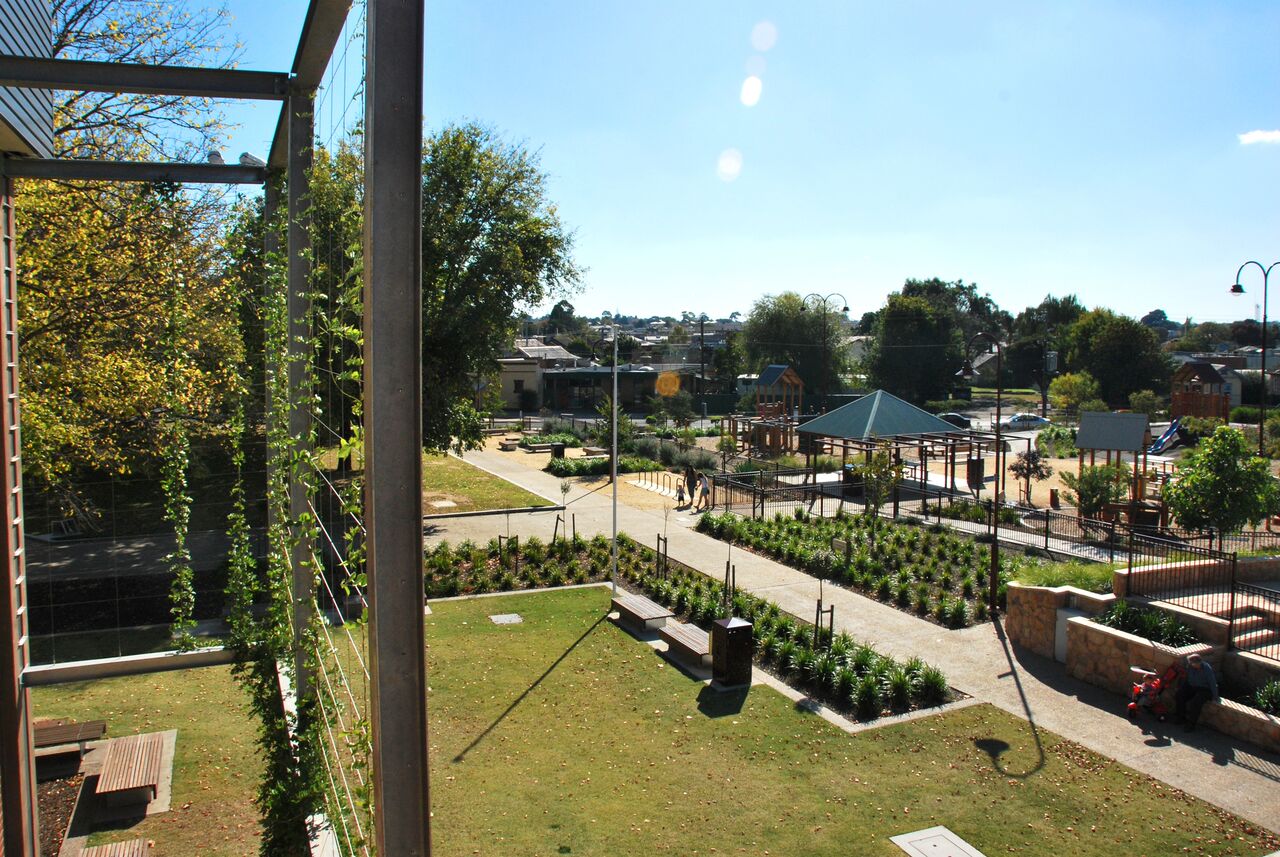
Hanging Gardens of Babylon aside, in the past the term roof garden usually meant a few wind pruned plants in pots, a bit of modular decking and a string of party lights left over from New Year’s Eve. But in more recent decades, things have seriously ramped up, so that landscape architects are now successfully creating treed garden spaces many floors above street level. One of these designers is Ruth Czermak, and the roof gardens she often creates are for smaller people...
Not that Ruth works solely producing roof gardens. Hers is an outwardly varied practice but at its core sits the constant themes of enrichment and sustainability. Armed with degrees in horticulture and landscape architecture (Burnely and University of Melbourne) she’s applied these two themes from the earliest days of her career. She set up her design and maintenance practice while she was still studying her first degree. She added a garden centre into the mix which exposed her to more clients. She then attacked her second degree and began lecturing at Melbourne on plants and materials. And when she won a tender to put rain gardens into schools, before having children of her own, she “spent time in schools at recess and lunchtime and saw that there was nothing for the children to do but play chasey, so I decided to incorporate more into the program.” Not only did those schools score rain gardens, but Ruth worked with staff to expose students to basic plant biology and the water cycle behind life on earth.
One thing usually leads to another, and Ruth was invited to speak about this schools’ work, and that led to the landscape design at the childcare centre re-development at Monash University. At this point she reactivated her design practice, jumping back into educational playgrounds and playspaces. But before she could settle into this niche, Ruth tackled another quite different project.
“I had an open brief to design the spaces surrounding a solar test facility at Bridgewater in central Victoria. We graded to direct water for the rain gardens and cooling, and positioned the portable buildings for the 12 staff to enhance the space, creating social areas, a communal kitchen, a walking track.” Another project Ruth then tackled nearby was a rethink and reconfiguration of the station precinct around Maryborough’s train station: reinstating an old road and adding the community space the town was lacking - a playground and an amphitheatre cum outdoor cinema. Like all Ruth’s projects, this one ticked off enrichment and sustainability.
But back to play spaces – of which Ruth does a fair bit – if we look closely at just one, you can appreciate the challenge involved in achieving sustainable, enriching spaces in a highly regulated sector, especially when you have to produce them off the ground.
The roof gardens Ruth designs are full of constraints. Before she starts drawing she runs potential materials through a combustibility audit and determines from the engineers where the weight – the sand pit and large planters – can be positioned. Of course the usual play space safely standards are met, as must the budget. Luckily the brief is open.
As Ruth tackles her ‘open’ brief, apart from creating sustainable spaces, the challenges Ruth sets herself are linked to enrichment. “The design needs to offer opportunities for the children whose age ranges from six weeks to six years, so we create spaces that are multi use.” With this flexibility built in, staff are able to set fresh activities and reconfigure spaces. For example, until the trees become established and offer leafy cover, teepees and pillows are set up for book time. A variety of materials are added to the mix to give feet and fingers different textures to experience. And the plant list is very carefully considered, not only to expose the children to living food but also the astonishing range of colour, texture and scent that the plant kingdom offers. There’s no question in Ruth’s mind that all this is important: the proof easily spotted – a sand mountain dotted with twigs created by a child, a little boy sitting engrossed examining the flower of a Kangaroo Paw. And since success of all this depends on the plants thriving, Ruth’s plant choices and positioning deliberately work to create gentler micro climates for plants and children alike. As for the artificial soil profiles she specifies, inspiration comes from her time spent talking to the growers of the plants: after all, the plants she uses are just being moved from their nursery pots to other purpose-built, lager versions on the roof of a building.
And there’s one other factor Ruth believes is important. The ability to maintain these spaces. “I’m a very practical person so I design considering the maintenance – for example no mud or sand play next to synthetic turf – and since most play centres rely on a maintenance person who might not be a gardener but who can replace an irrigation head, the spaces we create need to be really robust. I want to be able to come back several years later when the trees have become established and have it all looking great.”

Ruth’s contribution to the area around Maryborough’s station has given this Victorian rural community an interesting, functioning and adaptable space. The vegetation will grow and so will the number of ways in which the precinct is used.

Creating a functional yet beautiful landscape around this solar energy testing facility (above) near Bridgewater was not only appropriate stewardship of the land, but it made life for the research staff much more pleasant when they were in residence (below).

